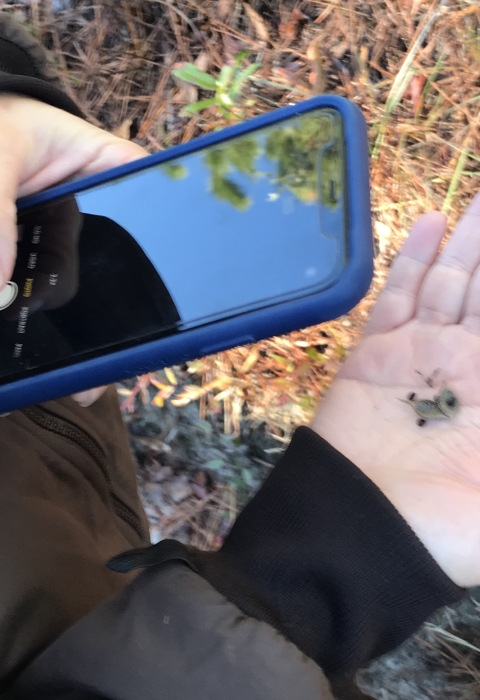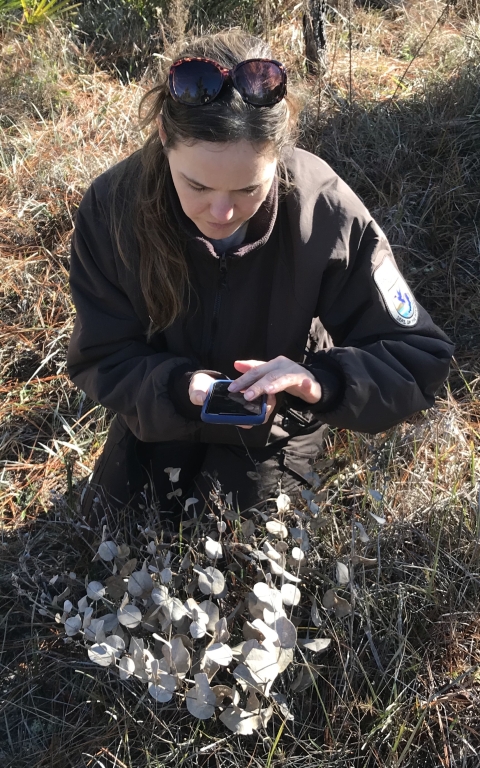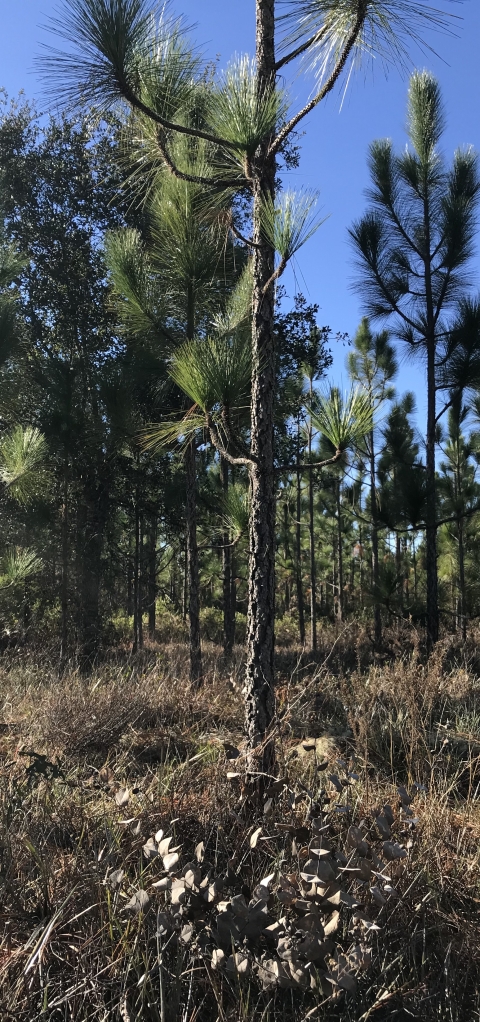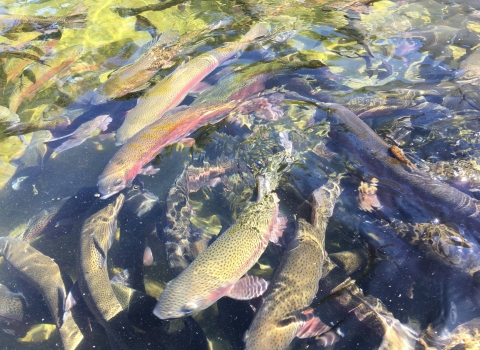Brunswick, Georgia — It sounds like the name of a punk rocker, or an illicit drug. It lurks under power lines, along roadsides and between rows of commercial pine trees. It’s covered in tiny, cobwebby hairs. It’s got a shape only a botanist could love.
Pity the little-known, inelegantly named hairy rattleweed, or Baptisia arachnifera. It is one of the nation’s rarest plants, found in only two southeast Georgia counties and federally listed as an endangered species. For decades virtually every rattleweed withered on the vine succumbing to logging, herbicides, absence of fire or indifference.
No longer. A consortium of government and nonprofit agencies, including the U.S. Fish and Wildlife Service and the Georgia Department of Natural Resources, announced recently that a 1,666-acre tract of timber company pinelands in rural Wayne and Brantley counties had been bought and preserved. More than 3,000 rattleweeds survive on a former Rayonier pine plantation alongside longleaf pines, saw palmettos and gallberry bushes.
Don Imm, a Fish and Wildlife supervisor in Georgia, said the state’s acquisition of the property represents “a huge step” toward the plant’s recovery and, perhaps, a downlisting from endangered to threatened.
Like many conservation efforts these days, the benefits of the so-called Hairy Rattleweed Protection Tract go well beyond the salvation of one species. Dozens of at-risk gopher tortoises live on site and their protection could reduce the possibility that the tank-like turtle will join the list of threatened or endangered species. There’s also a good chance that endangered and enchanting eastern indigo snakes live on the property. The land also serves as a critical piece of an under-construction wildlife corridor wildlife corridor
To maintain healthy species populations and ecosystems, fish and wildlife need the freedom to move and migrate. As habitats and migration routes are affected by climate change and fragmented by roads, fences, energy development and other man-made barriers, wildlife struggle to reach necessary areas to feed, breed and find shelter. A wildlife corridor is a piece of undeveloped land connecting two habitats so wildlife can move safely between them.
Learn more about wildlife corridor stretching from the Atlantic Ocean to the Gulf of Mexico.
“But the hairy rattleweed, by itself, is a special endemic that occurs nowhere else,” said Jason Lee, the coastal wildlife manager for the Georgia Department of Natural Resources. “That makes it worth protecting. It’s part of our national heritage right here in Georgia.”
A hairy rattleweed is hard to find and, once found, hard to love. A member of the bean family, it stands two-to-three feet tall with a reddish-brown stem and thick, silvery-white hairs covering all but its rounded or heart-shaped leaves. It can look scraggly, pathetic even, except when blooming yellow in the summer.
“Of course botanists think these plant species are awesome and amazing,” said botanist April Punsalan, who’s also the Service’s rattleweed recovery expert.
Rattleweeds live in only a narrow, 125-mile long swath of sandy soils west of Interstate 95. Most are tucked into pine plantations or under powerlines in between swamps and marshes. They prefer longleaf pine ecosystems with plenty of open space and sunlight and frequent fires to rid the understory of woody competition. Longleaf forests, though, have mostly disappeared under the woodman’s ax and, consequently, so have the rattleweeds.
“There has been a drastic reduction in population size and plant growth and reproduction since 1986,” reads a decade-old report by state biologists. “The species is apparently on the brink of extinction.”
About 90 percent of rattleweeds live on private pine plantations. Timber companies’ preference for quick-growing loblolly pine, with its dense canopy and absence of fire, isn’t conducive to hairy rattleweed propagation. Botanists, in August 2019, tallied 28 populations of hairy rattleweeds in the two counties. Only two groups, though, were considered stable or increasing. The first, alongside a sandy road and beneath a power line, held 98 plants. Georgia Power has designated the right-of-way a “special management area” and curtails mowing and herbicide spraying, particularly during the rattleweed’s flowering and fruiting period from May to November. The second, the so-called Lewis Tract, an easement held by The Nature Conservancy in Brantley County, counts between 150 and 200 plants. The nonprofit, which received a $500,000 species recovery grant from the Service in 2008, burns the property every couple of years. Punsalan says the prescribed fire, along with selective logging to let more sun hit the ground, fuels the steady growth of the tract’s rattleweed population.
She and Lee were joined by Jacob Thompson, a coastal DNR botanist, and Maria Whitehead with the Open Space Institute (OSI), a New York nonprofit and relative newcomer to Georgia conservation. It was a cool, blue-sky morning as they cruised the sandy backroads and forested tracts filled with gallberry and palmetto in search of the elusive rattleweed.
“That’s the hairy rattleweed there,” Thompson said, “that brown plant.”
He pointed out another. And another. This was the famed Lowalt Tract owned until recently by Rayonier, the timber and real estate company. At least 3,000 rattleweeds dot the nearly 1,700-acre property, by far the greatest assemblage of the endangered plants in the world. Thompson and others credit Rayonier for planting longleaf and burning the understory the last decade to boost rattleweed and gopher tortoise habitat. OSI bought the tract from Rayonier and held onto it until Georgia, the Service and the Knobloch Family Foundation ponied up roughly $3.5 million.
Downlisting the rattleweed from endangered to threatened, according to the Service’s recovery plan, requires four self-sustaining populations, or sites, each with a minimum of 100 plants. (Delisting requires eight populations.) The Rayonier, Lewis and Georgia Power tracts just about meet the downlisting criteria. Punsalan says a conservation victory is close at hand.
“All we need is one more population. That’s it,” she said. “Making sure rattleweeds stay on the landscape is an important indicator that we’re doing the right thing to protect the biodiversity of the southeast grasslands and a critically imperiled ecosystem.”
The benefits travel far beyond some funny-looking plants. The Rayonier rattleweeds share a 150-acre upland habitat with an estimated 50 gopher tortoises. About half of the entire tract is also home to forested, freshwater wetlands – prime habitat for federally threatened eastern indigo snakes, waterfowl and other animals. And the state of Georgia, in its wildlife action plan, lists the Rayonier tract as a critical link in a wildlife corridor encompassing Fort Stewart, the Altamaha River, the Okefenokee National Wildlife Refuge and the Osceola National Forest.
“You can connect habitats for all sorts of species — plants, snakes, red-cockaded woodpeckers, gopher tortoises, black bears, migratory birds — so they can roam from the Atlantic Ocean to, eventually, the Gulf of Mexico,” the DNR’s Lee said.
Maybe the lowly rattleweed deserves more credit.
“This time of year is the worst time to see the hairy rattleweed,” said botanist Thompson. “It’s all died back and brown. It’s the dormant season. But it stands out in the summer.”





